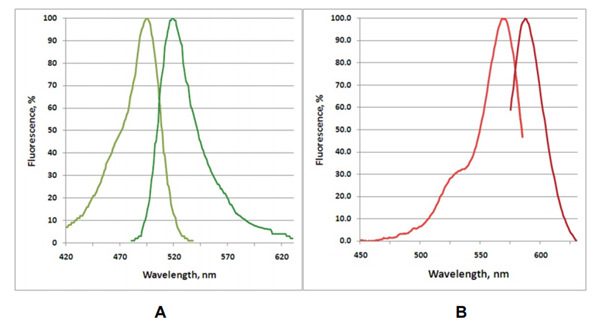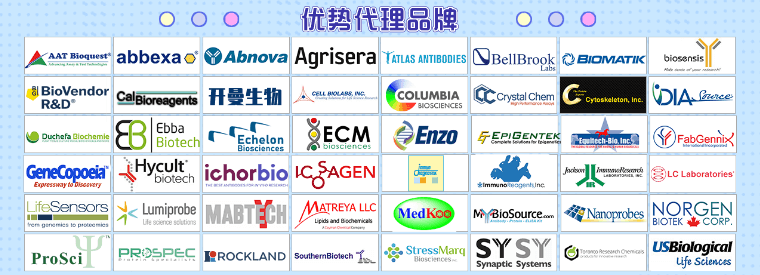您是否在面对复杂多变的细胞模型时,对于如何准确测量细胞内的缺氧和氧化应激水平感到困扰?
是否为了进行这一组检测而需要购买两套试剂盒而感到担忧高昂的成本?
您是否对传统的检测方法感到繁琐,并且对结果的可靠性存有疑虑?
在生命科学的前沿探索中,准确评估细胞的缺氧与氧化应激状态,对于揭示疾病机理、优化治疗策略至关重要。如今,Enzo Life Sciences倾情推出ROS-ID® Hypoxia/Oxidative Stress Detection Kit(ENZ-51042-0125,ENZ-51042-K500),这是一款专为科研人员设计,二合一的创新工具,艾美捷为您推荐的ROS-ID® 试剂盒直击这一系列挑战,以其独特的双色荧光标记技术,为您带来前所未有的清晰视野。它不仅能够直观区分缺氧与氧化应激状态,还能确保实验结果的准确性和重复性,让您的研究数据更加信服有力。
| 名称 | 货号 | 规格 | 用途 | 检测方式 |
| ROS-ID® Hypoxia/Oxidative stress detection kit | ENZ-51042-0125 ENZ-51042-K500 |
125T 500T |
活细胞(悬浮细胞,贴壁细胞) | 流式细胞术,荧光显微镜 |
* 可单独检测低氧,ROS氧化应激,亦可同时检测!
高度敏感且特异的荧光探针,可测量活细胞中的缺氧和氧化应激 适用于附着或悬浮细胞系 包括ROS和缺氧诱导剂在内的完整试剂盒 Enzo Life Sciences的ROS-ID®缺氧/氧化应激检测套装旨在功能性检测活细胞(悬浮和附着细胞均适用)中的缺氧和氧化应激水平,可使用荧光显微镜或流式细胞术。该套装包括缺氧(红色)和氧化应激水平(绿色)的荧光探针作为两个主要组成部分。
实验原理概述:
1、缺氧检测(红色):缺氧检测试剂(Red Hypoxia Detection Reagent)是一种非荧光或弱荧光的芳香族化合物,含有硝基(NO2)基团。在缺氧细胞中,由于存在硝基还原酶活性,硝基团通过一系列化学反应被转化为羟胺(NHOH)和氨基(NH2)基团,导致原始分子降解并释放出荧光探针,从而在荧光显微镜下呈现红色荧光。
2、氧化应激检测(绿色):氧化应激检测试剂(Oxidative Stress Detection Reagent)为非荧光、细胞可渗透的总ROS检测染料,能直接与多种活性氧物种反应,如过氧化氢、过氧亚硝酸盐和羟基自由基,生成绿色荧光产物,指示不同类型的ROS/RNS产生。此探针对超氧化物、活性氯或溴物种相对不敏感。
产品亮点
1、精准检测,双管齐下:该套件同时提供绿色荧光的氧化应激检测试剂与红色荧光的缺氧检测试剂,分别对应细胞内ROS水平与缺氧环境,实现精准定位与定量。
2、广泛适用,兼容性强:无论是贴壁细胞还是悬浮细胞,无论是采用荧光显微镜还是流式细胞仪,ROS-ID®套件都能灵活适应,满足您多样化的实验需求。两种规格(ENZ-51042-K500与ENZ-51042-0125)量身定制,灵活选择,经济高效。
3、操作简便,效率提升:我们对ROS-ID® Hypoxia/Oxidative Stress Detection Mix的准备过程进行了优化,确保实验准备简单快捷,减少实验误差,提升整体研究效率。
4、结果可视化,直观可信:实验设计包含正负对照,确保每次实验都有基准参考,使您的研究结论更具说服力。荧光信号直观显示,细胞状态一目了然,便于数据分析与解读。
结果分享:

图 1. 氧化应激(A)和低氧(B)检测染料的吸收峰和发射峰分别为504 nm/524 nm和580 nm/595 nm。这些染料可以使用488 nm的氩离子激光器激发,并在大多数实验流式细胞仪的FL3通道(低氧红染料)和FL1通道(氧化应激染料)上检测。

图 2. HeLa 细胞被种在显微镜载玻片上,第二天按照手册描述,用 DFO(低氧的化学诱导剂)或吡咯烷酮(氧化应激诱导剂)处理 4 小时,温度为 37°C。处理后,载玻片用 PBS 洗涤,盖上盖玻片,并使用 Olympus BX-51 荧光显微镜进行可视化观察。

图3. 培养的人类HeLa和HL-60细胞中缺氧和氧化应激水平的检测。细胞用缺氧诱导剂(DFO)和ROS诱导剂(花青素)处理。每个象限中的数字表示细胞(总体)的百分比。结果表明,缺氧和氧化应激染料具有特异性。
产品详情:
应用:流式细胞术,荧光显微镜,荧光检测,高通量筛选
应用说明:此试剂盒设计用于使用贴壁或悬浮细胞进行荧光显微镜和/或流式细胞术。
质量控制:使用流式细胞术方法进行测试,评估低氧细胞和/或具有高水平总氧化应激的细胞,并结合染料(试剂盒中提供)。还获得显微镜图像。
数量:对于-K500规格: 500次荧光显微镜分析或100次流式细胞分析。
对于-0125规格: 125次荧光显微镜分析或25次流式细胞分析。
使用/稳定性:在适当的储存条件下,试剂盒成分稳定,直到产品标签上注明的日期。
处理:避免冻融循环。
运输:干冰
短期储存:-20°C
长期储存:-20°C
【附录】发表文章:
Anoxia Rapidly Induces Changes in Expression of a Large and Diverse Set of Genes in Endothelial Cells: A. Antonelli, et al.; Int. J. Mol. Sci. 24, 5157 (2023), Abstract;
Cupric-ion-promoted fabrication of oxygen-replenishing nanotherapeutics for synergistic chemo and photodynamic therapy against tumor hypoxia: L. He, et al.; Acta Biomater. 162, 57 (2023), Abstract;
Precise manipulation of circadian clock using MnO2 nanocapsules to amplify photodynamic therapy for osteosarcoma: Y.X. Ge, et al.; Mater. Today Bio 19, 100547 (2023), Abstract;
The impact of hypoxia and oxidative stress on proteo-metabolomic alterations of 3D cholangiocarcinoma models: P. Phukhum, et al.; Sci. Rep. 13, 3072 (2023), Abstract;
Dimethyloxalylglycine (DMOG), a Hypoxia Mimetic Agent, Does Not Replicate a Rat Pheochromocytoma (PC12) Cell Biological Response to Reduced Oxygen Culture: R. Chen, et al.; Biomolecules 12, 541 (2022), Abstract;
Hydrogel microcapsules containing engineered bacteria for sustained production and release of protein drugs: C. Han, et al.; Biomaterials 287, 121619 (2022), Abstract;
Inhibiting autophagy flux and DNA repair of tumor cells to boost radiotherapy of orthotopic glioblastoma: Q. Xu, et al.; Biomaterials 280, 121287 (2022), Abstract;
Intracellular glucose starvation affects gingival homeostasis and autophagy: R. Li, et al.; Sci. Rep. 12, 1230 (2022), Abstract;
Intrinsic radical species scavenging activities of tea polyphenols nanoparticles block pyroptosis in endotoxin-induced sepsis: Y. Chen, et al.; ACS Nano 16, 2429 (2022), Abstract;
Iodinated cyanine dye-based nanosystem for synergistic phototherapy and hypoxia-activated bioreductive therapy: Y. Dong, et al.; Drug Deliv. 29, 238 (2022), Abstract;
Lipoprotein-biomimetic nanostructure enables tumor-targeted penetration delivery for enhanced photo-gene therapy towards glioma: R. Wang, et al.; Bioact. Mater. 13, 286 (2022), Abstract;
Microenvironment-driven sequential ferroptosis, photodynamic therapy, and chemotherapy for targeted breast cancer therapy by a cancer-cell-membrane-coated nanoscale metal-organic framework: W.L. Pan ,et al.; Biomaterials 283, 121559 (2022), Abstract;
Mitochondrial glutathione depletion nanoshuttles for oxygen-irrelevant free radicals generation: A cascaded hierarchical targeting and theranostic strategy against hypoxic tumor: B. Liang, et al.; ACS Appl. Mater. Interfaces 14, 13038 (2022), Abstract;
Multifunctional Nanosnowflakes for T1-T2 Double-Contrast Enhanced MRI and PAI Guided Oxygen Self-Supplementing Effective Anti-Tumor Therapy: Y. Lv, et al.; Int. J. Nanomedicine 17, 4619 (2022), Abstract;
Physiologic flow-conditioning limits vascular dysfunction in engineered human capillaries: K. Haase, et al.; Biomaterials 280, 121248 (2022), Abstract;
Platinum prodrug nanoparticles inhibiting tumor recurrence and metastasis by concurrent chemoradiotherapy: W. Jiang, et al.; J. Nanobiotechnology 20, 129 (2022), Abstract;
Strategy for improving cell-mediated vascularized soft tissue formation in a hydrogen peroxide-triggered chemically-crosslinked hydrogel: S.Y. Wei, et al.; J. Tissue. Eng. 13, 20417314221084096 (2022), Abstract; Full Text
A cyclic nano-reactor achieving enhanced photodynamic tumor therapy by reversing multiple resistances: P. Liu, et al.; J. Nanobiotechnology 19, 149 (2021), Abstract; Full Text
An albumin-based therapeutic nanosystem for photosensitizer/protein co-delivery to realize synergistic cancer therapy: S.L. Ai, et al.; ACS Appl. Bio. Mater. 4, 4946 (2021), Abstract;
An injectable hydrogel co-loading with cyanobacteria and upconversion nanoparticles for enhanced photodynamic tumor therapy: X. Zhang, et al.; Colloids Surf. B. Biointerfaces 201, 111640 (2021), Abstract;
Biomimetic nanoreactor for targeted cancer starvation therapy and cascade amplificated chemotherapy: F. Shao, et al.; Biomaterials 274, 120869 (2021), Abstract;
Bone-targeted erythrocyte-cancer hybrid membrane-camouflaged nanoparticles for enhancing photothermal and hypoxia-activated chemotherapy of bone invasion by OSCC: H. Chen, et al.; J. Nanobiotechnology 19, 342 (2021), Abstract; Full Text
Combination of coumarin and doxorubicin induces drug-resistant acute myeloid leukemia cell death: N.S. Al-Abbas, et al.; Heliyon 7, e06255 (2021), Abstract; Full Text
Encapsulating an acid-activatable phthalocyanine–doxorubicin conjugate and the hypoxia-sensitive tirapazamine in polymeric micelles for multimodal cancer therapy: X. Guo, et al.; Biomater. Sci. 9, 4936 (2021), Abstract;
Exploiting the acquired vulnerability of cisplatin-resistant tumors with a hypoxia-amplifying DNA repair-inhibiting (HYDRI) nanomedicine: J. Chen, et al.; Sci. Adv. 7, 5267 (2021), Abstract;
Extracellular matrix-induced GM-CSF and hypoxia Promote Immune Control of Mycobacterium tuberculosis in Human In Vitro Granulomas: A. Arbues, et al.; Front. Immunol. 12, 727508 (2021), Abstract; Full Text
Immune/Hypoxic Tumor Microenvironment Regulation-Enhanced Photodynamic Treatment Realized by pH-Responsive Phase Transition-Targeting Nanobubbles: M. Zhao, et al.; ACS Appl. Mater. Interfaces 13, 32763 (2021), Abstract;
Mitochondria-targeted and ultrasound-responsive nanoparticles for oxygen and nitric oxide codelivery to reverse immunosuppression and enhance sonodynamic therapy for immune activation: C. Ji, et al.; Theranostics 11, 8587 (2021), Abstract; Full Text
MnO2-based nanomotors with active fenton-like Mn2+ delivery for enhanced chemodynamic therapy: J. Ou, et al.; ACS Appl. Mater. Interfaces 13, 38050 (2021), Abstract;
Mucin 1 regulates the hypoxia response in head and neck cancer cells: K. Utispan, et al.; J. Pharmacol. Sci. 147, 331 (2021), Abstract;
Ruthenium (II) complexes coordinated to graphitic carbon nitride: Oxygen self-sufficient photosensitizers which produce multiple ROS for photodynamic therapy in hypoxia: F. Wei, et al.; Biomaterials 276, 121064 (2021), Abstract;
Stratified 3D microtumors as organotypic testing platforms for screening pancreatic cancer therapies: M.V. Monteiro, et al.; Small Methods 5, e2001207 (2021), Abstract;
Synergy of hypoxia relief and heat shock protein inhibition for phototherapy enhancement: G. Zhang, et al.; J. Nanobiotechnology 19, 9 (2021), Abstract; Full Text
The New Serum-Free OptiPASS ® Medium in Cold and Oxygen-Free Conditions: An Innovative Conservation Method for the Preservation of MDA-MB-231 Triple Negative Breast Cancer Spheroids: A. Goisnard, et al.; Cancers 13, 1945 (2021), Abstract; Full Text
Biomimetic decoy inhibits tumor growth and lung metastasis by reversing the drawbacks of sonodynamic therapy: H. Zhao, et al.; Adv. Healthc. Mater. 9, e1901335 (2020), Application(s): Fluorescence microscopy using 4T1 cells, Abstract;
Remodeling extracellular matrix based on functional covalent organic framework to enhance tumor photodynamic therapy: S.B. Wang, et al.; Biomaterials 234, 119772 (2020), Application(s): Fluorescence microscopy using CT26 cells, Abstract;
A two-photon excited O2-evolving nanocomposite for efficient photodynamic therapy against hypoxic tumor: R.Q. Li, et al.; Biomaterials 194, 84 (2019), Application(s): Fluorescence microscopy using 4T1 cells, Abstract;
Combinational phototherapy and hypoxia-activated chemotherapy favoring antitumor immune responses: B. Ma, et al.; Int. J. Nanomedicine 14, 4541 (2019), Application(s): Fluorescence microscopy using 4T1 cells, Abstract; Full Text
Di-(2-ethylhexyl) phthalate (DEHP) inhibits steroidogenesis and induces mitochondria-ROS mediated apoptosis in rat ovarian granulosa cells: A. Tripathi, et al.; Toxicol. Res. (Camb.) 8, 381 (2019), Application(s): Flow cytometry using granulosa cells, Abstract;
Encircling granulosa cells protects against di-(2-ethylhexyl)phthalate-induced apoptosis in rat oocytes cultured in vitro: A. Tripathi, et al.; Zygote 27, 203 (2019), Abstract;
Endogenous oxygen generating multifunctional theranostic nanoplatform for enhanced photodynamic-photothermal therapy and multimodal imaging: K. Wu, et al.; Theranostics 9, 7697 (2019), Application(s): Confocal microscopy using HeLa cells, Abstract; Full Text
Glutathione depletion and dual-model oxygen balance disruption for photodynamic therapy enhancement: W. Li, et al.; Colloids Surf. B Biointerfaces 183, 110453 (2019), Application(s): Fluorescence microscopy using 4T1 cells, Abstract;
Investigation of PPIX-Lipo-MnO2 to enhance photodynamic therapy by improving tumor hypoxia: L. Chudal, et al.; Mater. Sci. Eng. C Mater. Biol. Appl. 104, 109979 (2019), Application(s): Fluorescence microscopy using MCF-7 cells, Abstract;
Laser-triggered polymeric lipoproteins for precision tumor penetrating theranostics: R. Wang, et al.; Biomaterials 221, 119413 (2019), Application(s): Fluorescence microscopy using 4T1 cells, Abstract;
Monodispersed copper (I)‐based nano metal–organic framework as a biodegradable drug carrier with enhanced photodynamic therapy efficacy: X. Cai, et al.; Adv. Sci. 6, 1900848 (2019), Application(s): Fluorescence microscopy using 4T1 cells, Abstract; Full Text
Oral ferroportin inhibitor ameliorates ineffective erythropoiesis in a model of β-thalassemia: V. Manolova, et al.; J. Clin. Invest. 130, 491 (2019), Application(s): Flow cytometry analysis using mouse red blood cells, Abstract;
Oxygen-supplementing mesoporous polydopamine nanosponges with WS2 QDs-embedded for CT/MSOT/MR imaging and thermoradiotherapy of hypoxic cancer: Y. Wang, et al.; Biomaterials 220, 119405 (2019), Application(s): Fluorescence microscopy using 4T1 cells, Abstract;
Self-generating oxygen enhanced mitochondrion-targeted photodynamic therapy for tumor treatment with hypoxia scavenging: Z. Yang, et al.; Theranostics 9, 6809 (2019), Application(s): Fluorescence microscopy using MKN-45P cells, Abstract; Full Text
Solid matrix-supported supercritical CO2 enhances extraction of γ-linolenic acid from the cyanobacterium Arthrospira (Spirulina) platensis and bioactivity evaluation: X. Yang, et al.; Mar. Drugs 17, 203 (2019), Application(s): Fluorescence microscopy using Zebrafish larvae, Abstract; Full Text
All-in-one theranostic nanoplatform based on hollow MoSx for photothermally-maneuvered oxygen self-enriched photodynamic therapy: J. Wang, et al.; Theranostics 8, 955 (2018), Application(s): Fluorescence microscopy using 4T1 cells, Abstract; Full Text
Fluorinated polymeric micelles to overcome hypoxia and enhance photodynamic cancer therapy: Q. Wang, et al.; Biomater. Sci. 6, 3096 (2018), Abstract;
High glucose-induced oxidative stress impairs proliferation and migration of human gingival fibroblasts: P. Buranasin, et al.; PLoS One 13, e0201855 (2018), Abstract; Full Text
Light-enhanced hypoxia-responsive nanoparticles for deep tumor penetration and combined chemo-photodynamic therapy: Z. Li, et al.; Chem. Commun. 54, 13127 (2018), Abstract;
LSD1 mediated changes in the local redox environment during the DNA damage response: M.L. Duquette, et al.; PLoS One 13, e0201907 (2018), Abstract; Full Text
Platelet-mimicking nanoparticles co-loaded with W18O49 and metformin alleviate tumor hypoxia for enhanced photodynamic therapy and photothermal therapy: H. Zuo, et al.; Acta Biomater. 80, 296 (2018), Abstract;
Tumor starvation induced spatiotemporal control over chemotherapy for synergistic therapy: M.K. Zhang, et al.; Small 14, e1803602 (2018), Abstract;
Investigating the application of a nitroreductase-expressing transgenic zebrafish line for high-throughput toxicity testing: A.C. Chlebowski, et al.; Toxicol. Rep. 4, 202 (2017), Application(s): Use of hypoxia detection reagent with zebrafish embryos,
Modulation of alveolar macrophage innate response in proinflammatory-, pro-oxidant-, and infection- models by mint extract and chemical constituents: Role of MAPKs: N. Yadav & H. Chandra; Immunobiology 223, 49 (2017), Abstract;
Nitroimidazole derivatives of polypyridyl ruthenium complexes: Towards understanding their anticancer activity and mode of action: O. Mazuryk, et al.; Eur. J. Pharm. Sci. 101, 43 (2017), Application(s): Flow cytometry analysis using HaCaT and PANC-1 cells, Abstract;
Prodrug-embedded angiogenic vessel-targeting nanoparticle: A positive feedback amplifier in hypoxia-induced chemo-photo therapy: D. Guo, et al.; Biomaterials 144, 188 (2017), Application(s):Condocal Microscopy, Abstract; Full Text
Tumor-penetrating nanoparticles for enhanced anticancer activity of combined photodynamic and hypoxia-activated therapy: Y. Wang, et al.; ACS Nano 11, 2227 (2017), Application(s): Flow cytometry analysis of mouse breast carcinoma cells, Abstract; Full Text
Analysis of a nitroreductase-based hypoxia sensor in primary neuronal cultures: B.N. Lizama-Manibusan, et al.; ACS Chem. Neurosci. 7, 1188 (2016), Abstract;
ERK2 and CHOP restrict the expression of the growth-arrest specific p20K lipocalin gene to G0: M.J. Erb, et al.; Mol. Cell. Biol. 36, 2890 (2016), Application(s): Hypoxia levels in chick embryo fibroblasts (CEF), Abstract;
Phagocyte respiratory burst activates macrophage erythropoietin signalling to promote acute inflammation resolution: B. Luo, et al.; Nat. Commun. 7, 12177 (2016), Application(s): Flow cytometry analysis of hypoxia in exudate leukocytes and peritoneum, Abstract; Full Text
Selective advantage of trisomic human cells cultured in non-standard conditions: S.D. Rutledge, et al.; Sci. Rep. 6, 22828 (2016), Application(s): Fluorescence microscopy on human colorectal adenocarcinoma DLD1 cells, Abstract; Full Text
Low-level light in combination with metabolic modulators for effective therapy of injured brain: T. Dong, et al.; J. Cereb. Blood Flow Metab. 35, 1435 (2015), Application(s): Immunofluorescence Assay, Abstract; Full Text
Quantitative measurement of redox potential in hypoxic cells using SERS nanosensors: J. Jiang, et al.; Nanoscale 6, 12104 (2014), Abstract;






